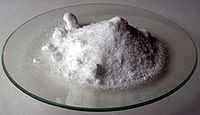Magnesium nitrate
| Magnesium nitrate | ||
|---|---|---|
 | ||
 | ||
| IUPAC name Magnesium nitrate | ||
| Other names Nitromagnesite (hexahydrate) | ||
| Identifiers | ||
| CAS number | 10377-60-3 15750-45-5 (dihydrate) 13446-18-9 (hexahydrate) | |
| PubChem | 25212 | |
| UN number | 1474 | |
| RTECS number | OM3750000 (anhydrous) OM3756000 (hexahydrate) | |
| Properties | ||
| Molecular formula | Mg(NO3)2 | |
| Molar mass | 148.32 g/mol (anhydrous) 184.35 g/mol (dihydrate) 256.41 g/mol (hexahydr.) | |
| Appearance | White crystalline solid | |
| Density | 2.3 g/cm3 (anhydrous) 2.0256 g/cm3 (dihydrate) 1.464 g/cm3 (hexahydrate) | |
| Melting point | 129 °C (dihydrate) 88.9 °C (hexahydrate) | |
| Boiling point | 330 °C (603 K) decomp. | |
| Solubility in water | 125 g/100 mL | |
| Solubility | moderately soluble in ethanol | |
| Refractive index (nD) | 1.34 (hexahydrate) | |
| Structure | ||
| Crystal structure | cubic | |
| Hazards | ||
| MSDS | External MSDS | |
| EU Index | Not listed | |
| R-phrases | R8, R36, R37, R38 | |
| S-phrases | S17, S26, S36 | |
| Main hazards | Irritant | |
| NFPA 704 |
 0
1
0
OX
| |
| Flash point | Non-flammable | |
| Related compounds | ||
| Other anions | Magnesium sulfate Magnesium chloride | |
| Other cations | Beryllium nitrate Calcium nitrate Strontium nitrate Barium nitrate | |
| Except where noted otherwise, data are given for materials in their standard state (at 25 °C (77 °F), 100 kPa) | ||
| Infobox references | ||
Magnesium nitrate is a hygroscopic salt with the formula Mg(NO3)2. In air, it quickly forms the hexahydrate with the formula Mg(NO3)2·6H2O (and molar weight of 256.41 g/mol). It is very soluble in both water and ethanol.
Uses
Magnesium nitrate occurs in mines and caverns as nitromagnesite. This form is not common, although it may be present where guano contacts magnesium-rich rock. It is used in the ceramics, printing, chemical and agriculture industries. Its fertilizer grade has 10.5% nitrogen and 9.4% magnesium, so it is listed as 10.5-0-0 + 9.4% Mg. Fertilizer blends containing magnesium nitrate usually have ammonium nitrate, calcium nitrate, potassium nitrate and micronutrients; these blends are used in the greenhouse and hydroponics trade.
Production
The magnesium nitrate used in commerce is a man-made product. It can be synthesized in a variety of ways. The reaction between nitric acid and magnesium metal
- 2 HNO3 + Mg → Mg(NO3)2 + H2
- 2 HNO3 + MgO → Mg(NO3)2 + H2O
results in magnesium nitrate.
Magnesium hydroxide and ammonium nitrate also react to form magnesium nitrate as ammonia is released as a by-product.
- Mg(OH)2 + 2 NH4NO3 → Mg(NO3)2 + 2 NH3 + 2 H2O
Reactions
Magnesium Nitrates with metal alkaline to form the corresponding nitrate
- Mg(NO3)2 + 2NaOH → Mg(OH)2 + 2NaNO3
Since magnesium nitrate has a high affinity for water, heating the hexahydrate does not result in the dehydration of the salt. Instead, magnesium nitrate hexahydrate decomposes into magnesium oxide, oxygen, and nitrogen oxides.
- 2 Mg(NO3)2 → 2 MgO + 4 NO2 + O2
The absorption of these nitrogen oxides in water is one possible route to synthesize nitric acid. Although it is inefficient, it does not require the use of another strong acid.
Anhydrous magnesium nitrate is also used to increase the concentration of nitric acid past its azeotrope of approximately 68% nitric acid and 32% water. It is also occasionally used as a desiccant.
References
External links
- International Chemical Safety Card 1041
- Liquid Chemistry
- Nitromagnesite Mineral Data
- Magnesium Nitrate MSDS
| |||||
| HNO3 | He | |||||||||||||||||
| LiNO3 | Be(NO3)2 | B(NO3)3 | C | N | O | F | Ne | |||||||||||
| NaNO3 | Mg(NO3)2 | Al(NO3)3 | Si | P | S | ClONO2 | Ar | |||||||||||
| KNO3 | Ca(NO3)2 | Sc(NO3)3 | Ti | V | Cr(NO3)3 | Mn(NO3)2 | Fe(NO3)3 | Co(NO3)2, Co(NO3)3 | Ni(NO3)2 | Cu(NO3)2 | Zn(NO3)2 | Ga(NO3)3 | Ge | As | Se | Br | Kr | |
| RbNO3 | Sr(NO3)2 | Y | Zr | Nb | Mo | Tc | Ru | Rh | Pd(NO3)2 | AgNO3 | Cd(NO3)2 | In | Sn | Sb | Te | I | Xe | |
| CsNO3 | Ba(NO3)2 | Hf | Ta | W | Re | Os | Ir | Pt | Au | Hg2(NO3)2, Hg(NO3)2 | Tl(NO3)3 | Pb(NO3)2 | Bi(NO3)3 | Po | At | Rn | ||
| Fr | Ra | Rf | Db | Sg | Bh | Hs | Mt | Ds | Rg | Cn | Uut | Fl | Uup | Lv | Uus | Uuo | ||
| ↓ | ||||||||||||||||||
| La | Ce | Pr | Nd | Pm | Sm | Eu | Gd(NO3)3 | Tb | Dy | Ho | Er | Tm | Yb | Lu | ||||
| Ac | Th | Pa | UO2(NO3)2 | Np | Pu | Am | Cm | Bk | Cf | Es | Fm | Md | No | Lr | ||||